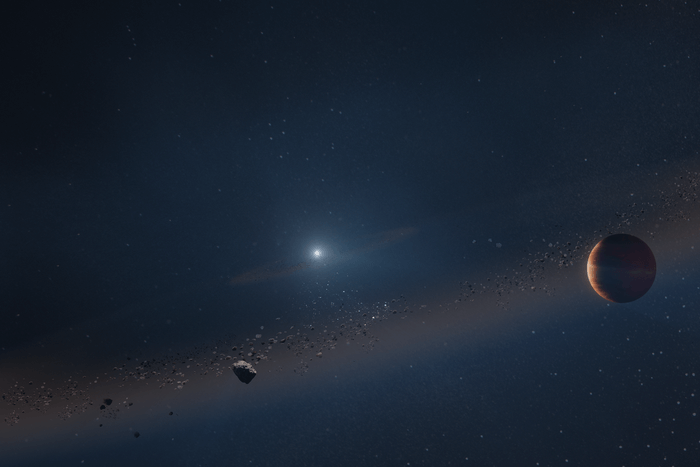
Artist’s rendition of a newly discovered Jupiter-like exoplanet orbiting a white dwarf, or dead star. This system is evidence that planets can survive their host star’s explosive red giant phase and is the very first confirmed planetary system that serves as an analog to the fate of the Sun and Jupiter in our own solar system. (CREDIT: W. M. Keck Observatory/Adam Makarenko)
MAUNAKEA, Hawaiʻi – A distant solar system similar to our own is giving scientists a glimpse into the future of the Sun. Astronomers in Hawaiʻi have discovered the first planetary system which has already gone through what scientists expect to happen in our solar system billions of years from now. That “crystal ball” into the future is allowing researchers to know which planets will likely survive the eventual death of the Sun.
A team at the W. M. Keck Observatory found a solar system near the center of the Milky Way galaxy which has a Jupiter-like planet in a Jupiter-like orbit around its sun. That distant star is now a white dwarf star — which is what suns like our own become at the end of their life cycles.
What does this mean for the planets in this solar system?
While the team believes Earth will become uninhabitable as the Sun dies out, this discovery points to larger planets like Jupiter and Saturn continuing to live on.
“This evidence confirms that planets orbiting at a large enough distance can continue to exist after their star’s death,” says lead author Joshua Blackman, an astronomy postdoctoral researcher at the University of Tasmania, in a media release. “Given that this system is an analog to our own solar system, it suggests that Jupiter and Saturn might survive the Sun’s red giant phase, when it runs out of nuclear fuel and self-destructs.”
“Earth’s future may not be so rosy because it is much closer to the Sun,” adds co-author David Bennett, a senior research scientist at the University of Maryland and NASA’s Goddard Space Flight Center. “If humankind wanted to move to a moon of Jupiter or Saturn before the Sun fried the Earth during its red supergiant phase, we’d still remain in orbit around the Sun, although we would not be able to rely on heat from the Sun as a white dwarf for very long.”
What will happen to the Sun?
Astronomers believe the final stage of life for main sequence stars (like the Sun) sees all of the hydrogen they carry burn out in its core. The star then balloons into a red giant star.
From there, the red giant collapses in on itself, shrinking into a white dwarf. The result is a hot and dense core about the size of the Earth which has half the mass as the original sun. Since these “dead” stars no longer contain nuclear fuel which radiates brightly into the cosmos, they are very hard to find out in space.
Researchers used the Keck Observatory’s laser guide star adaptive optics system and its Near-Infrared Camera (NIRC2) to get high-resolution images of this solar system. They found that the white dwarf is about 60 percent as massive as our Sun. Its surviving planet is a gas giant world (like Jupiter and Saturn) which is about 40 percent bigger than Jupiter.
The team also ruled out the possibility that this planet is circling a black hole or brown dwarf star, meaning they're confident this is a white dwarf and a peek into our solar system's distant future.
“We have also been able to rule out the possibility of a neutron star or a black hole host. This means that the planet is orbiting a dead star, a white dwarf,” explains co-author Jean-Philippe Beaulieu, the Warren chair of Astrophysics at the University of Tasmania. “It offers a glimpse into what our solar system will look like after the disappearance of the Earth, whipped out in the cataclysmic demise of our Sun.”
The findings appear in the journal Nature.











Who writes this OBVIOUS drivel? Worse, who is the editor that allowed it?